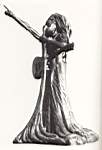Excerpt from Lecture No. 8
Delivered by Petrine Archer-Straw
 In this month's lecture presentation we examine the Bob Marley Monument by Christopher Gonzales. Although, technically, there is a certain amount of ambiguity concerning formal ownership of this work, since May 1983 this monument has been on display at the National Gallery Collection. Certainly, it can be regarded as a masterpiece work, embodying a symbolism which has provoked much controversy and has made this piece one of the most famous artworks in Jamaican art history. (Watch the video)
In this month's lecture presentation we examine the Bob Marley Monument by Christopher Gonzales. Although, technically, there is a certain amount of ambiguity concerning formal ownership of this work, since May 1983 this monument has been on display at the National Gallery Collection. Certainly, it can be regarded as a masterpiece work, embodying a symbolism which has provoked much controversy and has made this piece one of the most famous artworks in Jamaican art history. (Watch the video)
Commissioned in 1981 by the Government of Jamaica, this work was created to honour the late reggae musician Bob Marley, and was originally intended for "Celebrity Park" - a newly created shrine for Jamaicans who had achieved international status and who had lived their lives in a manner which brought pride and fame to Jamaica.
Physically, the sculpture is an imposing one, created for and certainly more suited to outdoor viewing. Standing at seven (7) feet nine (9) inches tall and cast in bronze, it dwarfs those viewers who pass within its wake. In the lobby of the National Gallery, its impact is immediate and gripping as the viewer is confronted with the dark and, somewhat, ominous image of the Rastaman who emerges from a tree-like base. Ambiguity and tension are communicated by the constant interchanges of organic forms head and loins are embraced by root-like forms, which flow from the head and merge with the base.
In one instance, they are locks which adorn the reggae King, in another, they merge to become the grossly phallic staff which is firmly gripped as a microphone. The body is lean, taut and well defined, suggestive of Bob's physique, while the torso, rippling with muscle, is a strong vertical thrust, conveyed by the rigid, steely-like spine transformed from the tree's bark and the outstretched hand with pointed fingers - characteristic of the artist. The bearded face, too, is upturned. Mouth open as if in a song, eyes closed as if in concentration, with the head appearing strangely large and overpowering, tilted as though weighted down by the locks which flow down the back of the statue, caressing the well shaped buttocks.
The image is naked, it is challenging, it is defiant and, from this point of view, it is successful because it communicates much of what the artist Gonzales wished to express about Bob Marley and Rastafari. His use of visual symbolism, though characteristic of his own work, coincides with Rastafari's use of allegory in speech and music, and is very much in tune with the hidden depths of reasoning in Bob Marley's own music. For each image employed in the monument, there is an attendant explanation and interpretation derived from Gonzales's understanding of Bob Marley - the musician and the Rastaman.
The theme of the tree relates to growth, more pointedly to spiritual growth. Christ used the symbol of the tree in a number of his parables. In this instance, the tree is symbolic of the biblical tribe of Joseph to which Bob Marley belonged and which is likened in the bible to 'a fruitful bough'.
Further, it relates to Bob Marley's coming to maturity as an internationally famed musician, as well as his spiritual growth as a member of Rastafari. The emphasis on the roots of this tree are also significant, for they refer to Bob as "Roots" man, conscious of his African heritage and humble beginnings. These roots transformed to branches, also form the dreadlocks adornment which conjure up images of Samson or John the Baptist and the Nazarenes - or the "Dread Monks" of the Himalayas, for whom the hair serves as an antenna for spirituality. The microphone, too, embodies hidden imagery, for this is the staff of the Rastaman - Joshua's rod of correction and a phallic symbol of Bob profolic as musician and man, and, the fruits and nuts which form the beard, speak to a continuation of this theme. But what of the face, what does this face symbolise? This is no photographic representation of Bob Marley. It is a universal image, a face which is a composite of Bob's many moods and emotions which go beyond the vanity of resemblance and exact representation.
The fact that this monument points beyond the musical image of Bob Marley was integral to Christopher Gonzales's understanding of Bob. For him, it is a universal image, the Rastaman who stands defiantly for the outcasts of society, who is also the conscious of the society, it represents the visual statement implicit in Bob's music.
When Christopher Gonzales was first selected to execute this project, congratulatory reports emphasized the artistic affinity between the two artists and Gonzalez had a spiritual affinity to Rastafari and a great love of Bob's music. Further, Gonzales's was considered a 'natural choice'. The Marley commission came to Gonzales at a time when he had developed a definitive style in his work. For him, the Marley piece was like a 'conglomeration' of what he had always wanted to do in sculpture.
Somewhat inevitably, Gonzales could not resist the message in Marley's music - he could not turn his back on a challenge to speak honestly of what that music represented. Somewhat inevitably Gonzales gravitated to the image of Rastafari - defiant, black, strong, powerful, spiritual and ensconced within those organic forms were images of Marley, images of Gonzales and images of Christ - a tormented, restless image of the oppressed who finally conquer over the wickedness of Babylon.